Ladies and gentlemen, it’s February. You know what that means? It’s time to get going. I can feel it, and I’ll bet you can too – that little twitch in your hand that says, “alright, baby, let’s start some tomatoes!”
February typically marks the beginning of the big seed starting effort around here. Not just this year’s crop of tomatoes, but nearly all of the first round of brassicas can be started this month.
So, let’s get going. Spring is on its way.
Printable At-A-Glance Grow-Guide!
If you like your Gardening To Lists simple and direct, you’re in luck! Just click the image below to download the February At-A-Glance Grow Guide as a printable PDF.
Or, continue reading for the full details on everything you should be doing in your garden this month.
Plan and Purchase
No pressure, but by now you should have a pretty good idea what you will be growing and where you will be growing it.
Seeds
If you’re still finalizing your seed order, don’t delay. Good seed houses do run out of varieties. I’m a fan of High Mowing Organic Seeds. (High Mowing’s been – but isn’t currently – a seasonal sponsor of this site.) Johnny’s Select Seeds gets high marks from me as well.
Feeling overwhelmed? Here’s a few resources for planning your garden and your seed order this year:
- How To Pick Your Vegetable Seeds Without Going Crazy
- How To Make Succession Planting and Year-Round Gardening Really Work
- Seed Selection Made Very, Very Simple
Order your seed potatoes ASAP for best selection. Popular and rare varieties tend to sell out quickly. If you’re a true potato junkie, Irish Eyes has the widest selection around, all certified organic.
Perennials
If you didn’t do it last month, now’s the time to order perennials, like fruit trees, shrubs, rhubarb and asparagus. These should be planted as soon as they arrive, while still dormant.
This month you’ll start to see bare-root fruit trees, bushes and canes at nurseries, but the best selection will be mail order. I have ordered from Raintree Nursery many times (their catalog is total garden porn) and have always been happy with the plant quality and customer service. Readers have also recommended Cloud Mountain Farm as a good supplier of fruit trees.
- Rhubarb Crowns
- Asparagus Crowns
- Bare Root Fruit Trees
- Bare Root Fruit Bushes
- Bare Root Cane Fruit & Vines
- Hop Rhizomes
Gear
All this seed starting info assumes you have what it takes to grow great seeds into great little seedlings. And, sad to say, in the Pacific Northwest that’s not just a South facing window.
Here is my opinionated take on which seed starting supplies are worth your hard-earned cash and which aren’t.
I’ve get a ton of questions this time of year about grow lights! I upgraded to the T5 grow light pictured below and it’s been a dream for me. This is the grow light I have – highly recommended.
Prepare and Prune
This is a great time to start thinking about warming your soil where you’ll be planting heat lovers like tomatoes and peppers.
If you aren’t opposed to using plastic in the garden, pin black plastic down over your beds for extra heat and weed suppression. Clear plastic actually warms soil even better, but allows weeds to germinate like crazy. If you plan to leave plastic on your beds the whole season and just plant through it, make sure you have a soaker hose or something to irrigate under the plastic.
You can also erect your low tunnels and cloches at this time of year, to help winter-water-logged soil dry out and warm. By the time your transplants are ready, the soil will be too.
There’s still time to handle dormant season pruning and spray fruit trees with dormant oil to control mites, scale and overwintering buggies. See January Gardening Chores For The Pacific Northwest for a recipe for my DIY All Natural Dormant Oil Spray For Fruit Trees.
Start Indoors
Whoa boy, here we go.
Perennials
- Asparagus: if you want to try growing asparagus from seed, you have to start now – the seeds can take almost a month to germinate. Personally, I’d buy 1 year old crowns from a good nursery or mail order seed company.
- Artichokes: I grow Green Globe and Violetta.
- Strawberries: I wouldn’t bother starting common garden strawberries from seed, but some of the rare alpine types might be worth a go from seed.
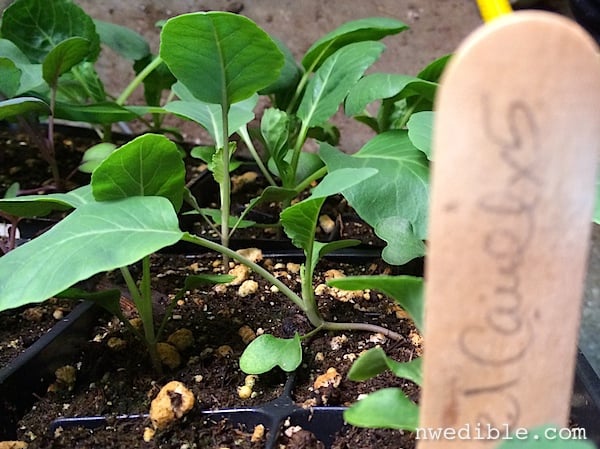
Brassicas
- Broccoli: early varieties should be started under lights this month for planting out under a cloche at the beginning of April. All around, I really like Belstar as a spring broccoli. It’s a solid performer in cool weather. Some seed companies do broccoli blends, which are useful to home gardeners who don’t want to worry about succession planting. Territorial offers a good one.
- Brussels Sprouts: early varieties should be started under lights mid-month for planting out under a cloche at the beginning of April. I prefer Brussels Sprouts as a cool season crop, and will start them in June to mature in mid-September for harvest through fall and winter.
- Cabbage: Be very careful about variety selection here. You want an early cabbage with a maturity date of around 60-80 days. The really long maturing cabbages are better suited for fall. Farao has been a standout variety in my garden. Start under lights mid-month for planting out under a cloche end of March/ beginning of April.
- Cauliflower: A bit more finicky than other brassicas, give special attention to your cauli seedlings with consistent moisture and lighting and regular organic feeding or slow release fertilizer in the grow medium. Early varieties should be started under lights late this month for planting out under a cloche at the beginning of April. I like Snowball, and Romanesco did very well for me last year too.
- Kohlrabi: I’ve done ok with Lech as a spring kohlrabi. I still find this this crop easier to grow for fall (use a large hardy kohlrabi like Superschmelz for that) but my husband adores kohlrabi so I try to grow more of it.
- Kale and Collards: If you want early cooking greens you can start them now. If your space under lights is limited, wait and sow them out directly under a cloche next month. Both these crops germinate and grow well, even in cool soils. I grow collards in the fall (champion is a fine vates-type) but lacinato kale is a year-round crop for me.
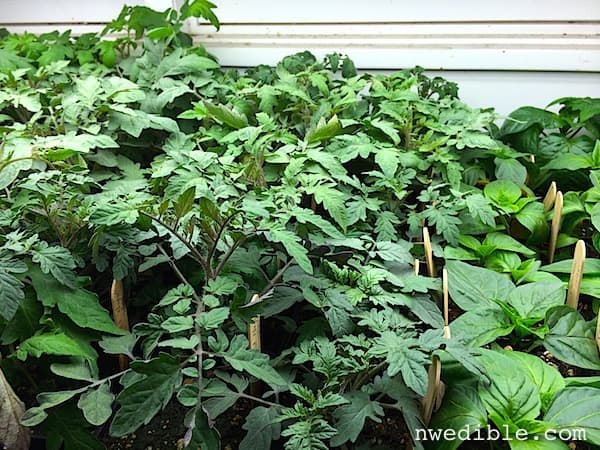
Nightshades
- Tomatoes: If you don’t mind fussing with your tomatoes and if you have good strong grow lights and if you are planning on season extension, you can start your tomatoes in February with plans to up-pot to gallons if necessary and transplant to a pre-warmed, tunnel-cloched bed in late April, depending on weather. If you just don’t want to put that much work into it, wait a month. My favorite tomato is Striped Roman. If you aren’t confident about tomatoes, grow the incredibly flavored cherry-type called Sungold.
- Hot and Sweet Peppers: I start these at the same time as tomatoes, knowing they will need more babying than ‘maters and will take longer to grow big. That extra grow-time on the bench is fine, since peppers can’t go out to the garden until June some years. I consistently have the best luck with smaller, hot peppers than thick walled bell types, but King of the North does alright in our climate.
- Eggplant: How many eggplants are you really gonna grow? Give these another month or two before you start them because they are quite tender. Or just buy quality starts in early June. The Asian and mini-type eggplants are better for the Pacific Northwest.
- Potato: These you don’t really “start” but you can chit your seed potatoes to get a jump start on the season.
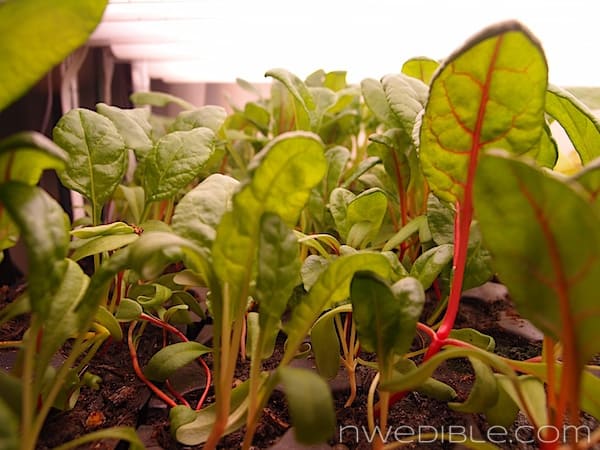
Leafy Greens and Herbs
- Chard: Start indoors now or wait a month and sow out directly. I grow rainbow chard.
- Salad Greens: Aim for a salad green sowing every month. New month? New sowing of lettuce, etc. That’ll give you edible salad greens in some stage of growth through October. It’s still quite early, so stick to the cool-weather cultivars like Winter Density.
- Spinach: I don’t think spinach is a great crop to start indoors. You go right ahead if you want, but I recommend broadcast sowing this crop outdoors for better results.
- Herbs: now is the time to sow seed for parsley, lemon verbena, chives, fennel, borage, chamomile, chervil and johnny-jump-ups (yes, they’re edible!)
Other Stuff
- Onions and Summer Leeks: You might have started these these guys last month, right? If not, you’ll want to jump on it early this month, or else place your order for onion plants. You’ll want long-day onion varieties if you’re in the Northwest. No short-days.
- Peas: For the earliest possible harvest, start these inside in a length of gutter. Transplant them out to a cloched bed when they are a few inches tall and plan for early peas.
Sow & Plant Outside
Seeds
- Peas: George Washington’s birthday (2/21) is the traditional time to sow peas. If the soil has warmed up and isn’t waterlogged, and if you didn’t sow peas indoors, the end of February is a good time to get them in the ground. If the soil still seems really cold and wet where you are, wait a few more weeks. Pretty much all peas grow well in the Northwest. I focus on Sugar Snap types.
- Favas: Direct sow anytime. When I grow favas, I grow the huge-seeded Broad Windsor.
- Garlic: You don’t have to do this because you got your garlic in last fall so it’s already showing 6 or 7 inches of shoot, right? Right? Oh, well, not to worry! Just stick some in now. Your garlic heads will be smaller but you’ll still have homegrown garlic.
- Salad Greens, Spinach, Asian Greens & European Greens: sow out the hardiest greens under cloche for the earliest possible direct seeded new crop greens.
- Radishes: the little globe ones. Try a pretty mix like Valentine’s Day.
- Onion Sets: for early green onions, you can plant sets now and use them before they bulb.
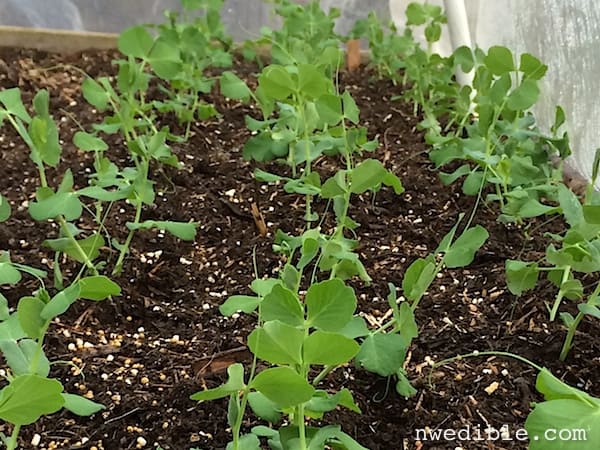
Perennials
With these perennials, pretty much if you can buy it right now, and the ground can be worked without turning to mud, you can plant.
- Bare root fruit trees: these should be put into previously prepared ground while still dormant.
- Bare root fruit bushes: These are your currants, gooseberries, blueberries, etc. Just like the trees, get these in the ground while still dormant.
- Cane fruits: Blackberries, raspberries, etc. available bare root now.
- Rhubarb crowns: These can be had by dividing established plants, ordered online, or purchased at a good nursery.
- Horseradish roots: these can be invasive! It’s a good idea to plant them in a very large container sunk into the ground to control their roaming. Of course, I didn’t listen to myself, I just stuck them in the ground last spring and now the roots are as big as my wrist and I’m kinda screwed. Oh well.
- Asparagus crowns: Easier than seed, these look like shriveled up sad, brown baby octopi when you first pull them out of the bag. They’ll settle in, though, and in a few years they will be monster plants with roots 8 feet deep. Asparagus is cool like that.
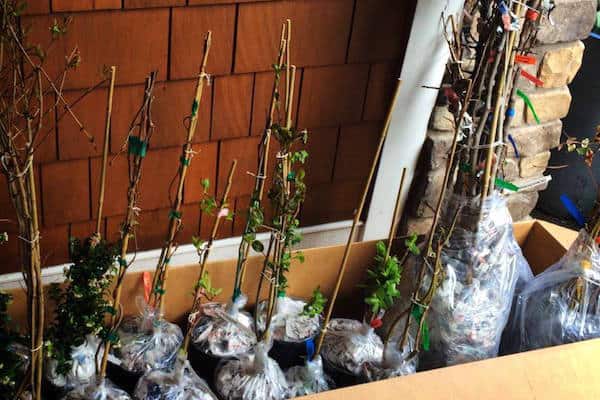
Harvest
Vegetables I’ve harvested in February include:
- Brussels Sprouts
- Overwintering Cabbage
- Carrots & Parsnips
- Kale and Collards
- Overwintering Cauliflower
- Sprouting Broccoli
- Winter Kohlrabi
- Chard
- Leeks
- Turnips & Rutabagas
- Protected Salad Greens, Asian Greens and Euro Greens
- Jerusalem Artichokes
- Stored Winter Squash
- Stored Potatoes
- Celeriac

What are you doing in your garden this month?
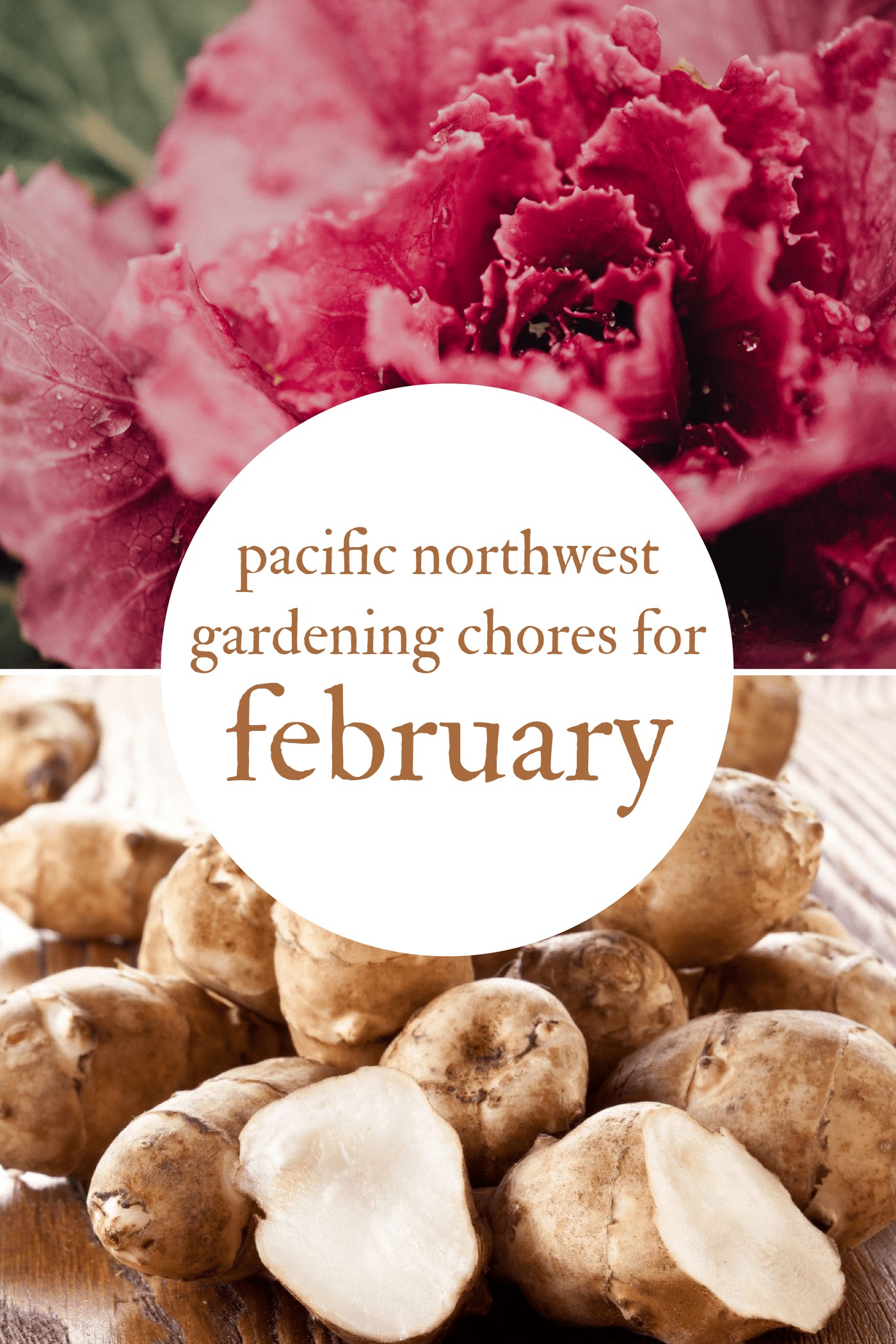

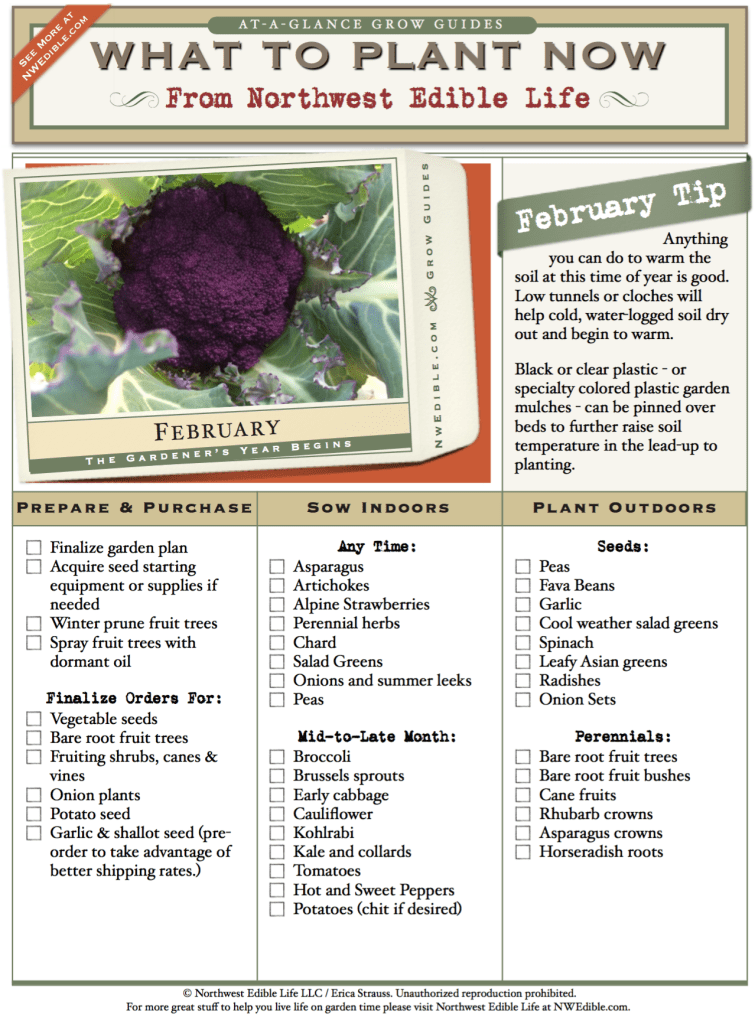
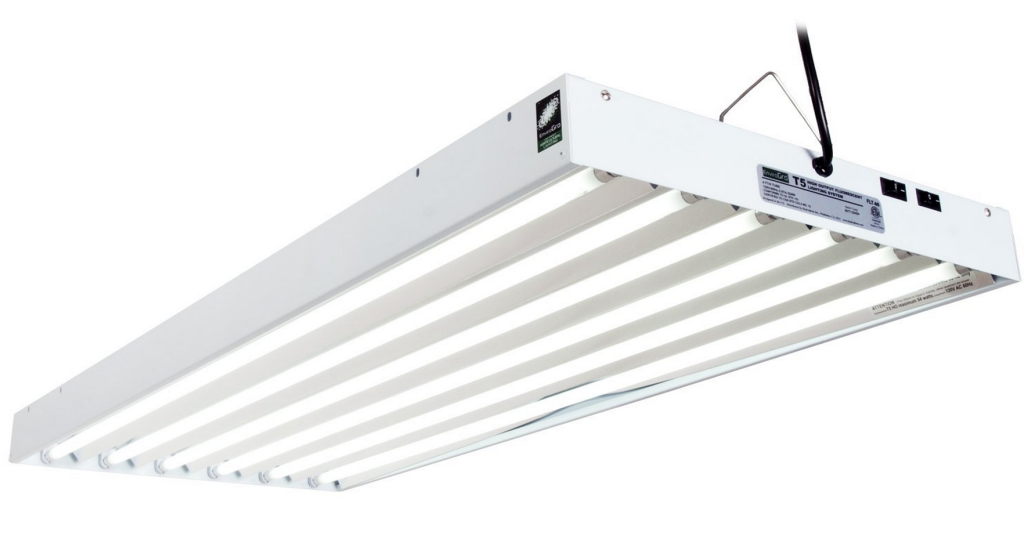
Here in SE Texas we’ve had many 70* days, plus an abnormally warm December, that has tempted many into thinking we’ll get by unscathed. We’ve had several near freezing mornings but only one night that was below freezing enough to upset some tender tropicals. However, February always likes to have the last word. We aren’t out of the woods yet.
In years past we’ve started our tomato seeds the first week or two of January. This year I started a few this last weekend but will buy starts in March as I did last year (new baby!). Our green season starts in October and will be done here by March/April, except for collards…they’ll go to June. My bok choy has already bolted and is done but kale and a few other greens are going strong so far. our potatoes will be planted this week.
Happy gardening!
How did we get here already?
This year, I have my heating mats and lights, so I am looking forward to the cost-savings of seed-starting, though having a bed of leeks through the winter went a long way towards paying them off. I started them last February and will be finishing them this February. Not bad for a packet of seeds.
It’s been a long winter without my kale plants. My spring-started plants did so fantastically, I didn’t sow a fall crop, which was a mistake. Buying kale just feels wrong!
Frantically getting my seed order/garden plan/starts going 😀
We never got our deep freeze with 3+ feet of snow this year so it will be an interesting growing season (Northwest PA).
Thanks for the reminder to get going!
Also for anyone who hasn’t bought Erica’s garden planner yet, it is awesome!
I teach at a middle school that has a greenhouse class that will grow my starts for me! Is starting seed in a greenhouse basically the same as starting it under lamps/with heated mats? It seems like lamps/mats might provide more consistent warmth given the 45 degree weather we have here in the Willamette Valley.
Oh yes, I feel the anticipation for spring building. The information was really useful and very helpful; I am starting to plan for my garden in earnest.
I’m trying to hold off this year, I get hit with vernilization often (early bolting due to exposure to cold when young). This year I vow to not lose a single allium or brassica to it. But greenhouse bound peppers and tomatoes are seeded. I did an early planting of peas under poly tunnels, the slugs really enjoyed them.
Any recommendations for how to time my Willamette Valley garden to accommodate a mid-June vacation? I’m trying to decide whether to hold off planting some of the big stuff until I get back, or put it all in the ground earlier than usual to give it time to get settled before I go. I planned to direct sow squash & melons this year since my transplants always seem to stall out. I also want to avoid relying on someone to babysit seed trays for a couple weeks.
I should mention, all the raised beds are under cloches already to dry out. I actually got my act together and installed plastic tunnels in December because of all the freezing we had.
Thanks to your advice, I’m hoping to convert a section of my lawn into more vegetable bed this year by laying down cardboard/newspaper, and then piling with compost. Do you think I’ll be able to plant in this bed this spring (I’m zone 6a) or am I dreaming?
Thanks for this article. I’m glad I seem to be on the right track! I’ve really got to get a handle on these weeds before I start planting my garden though.
Hey Erica, I’m just reading the February To Do list (you know me, always a month behind), and just noticed that your check list mentions sowing indoors in mid March. For this list, shouldn’t it be mid February. Just thought I’d mentioned it. 🙂
Barb
hey Erika, tried to download the PDF for this month and got a dropbox error. Can you repost or email me the pdf directly? I’m trying to keep up with this year’s garden chores by putting them together with my gardening plan in a binder.
thanks!
I’m sorry about this Susan – something is up with several of my files and I have to go sort out what’s gone wrong. I’ve been out of town, but I’ll figure it out.